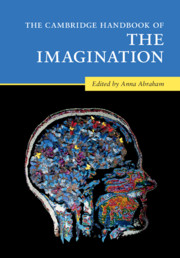Book contents
- The Cambridge Handbook of the Imagination
- The Cambridge Handbook of the Imagination
- Copyright page
- Dedication
- Contents
- Figures
- Contributors
- Acknowledgments
- 1 Surveying the Imagination Landscape
- Part I Theoretical Perspectives on the Imagination
- Part II Imagery-Based Forms of the Imagination
- Part III Intentionality-Based Forms of the Imagination
- 19 Continuities and Discontinuities Between Imagination and Memory: The View from Philosophy
- 20 Imagining and Experiencing the Self on Cognitive Maps
- 21 The Neuroscience of Imaginative Thought: An Integrative Framework
- 22 Imagination and Self-Referential Thinking
- 23 Imaginary Friends: How Imaginary Minds Mimic Real Life
- 24 Imagination and Moral Cognition
- 25 Moral Reasoning: A Network Neuroscience Perspective
- 26 The Future-Directed Functions of the Imagination: From Prediction to Metaforesight
- Part IV Novel Combinatorial Forms of the Imagination
- Part V Phenomenology-Based Forms of the Imagination
- Part VI Altered States of the Imagination
- Name Index
- Subject Index
- References
21 - The Neuroscience of Imaginative Thought: An Integrative Framework
from Part III - Intentionality-Based Forms of the Imagination
Published online by Cambridge University Press: 26 May 2020
- The Cambridge Handbook of the Imagination
- The Cambridge Handbook of the Imagination
- Copyright page
- Dedication
- Contents
- Figures
- Contributors
- Acknowledgments
- 1 Surveying the Imagination Landscape
- Part I Theoretical Perspectives on the Imagination
- Part II Imagery-Based Forms of the Imagination
- Part III Intentionality-Based Forms of the Imagination
- 19 Continuities and Discontinuities Between Imagination and Memory: The View from Philosophy
- 20 Imagining and Experiencing the Self on Cognitive Maps
- 21 The Neuroscience of Imaginative Thought: An Integrative Framework
- 22 Imagination and Self-Referential Thinking
- 23 Imaginary Friends: How Imaginary Minds Mimic Real Life
- 24 Imagination and Moral Cognition
- 25 Moral Reasoning: A Network Neuroscience Perspective
- 26 The Future-Directed Functions of the Imagination: From Prediction to Metaforesight
- Part IV Novel Combinatorial Forms of the Imagination
- Part V Phenomenology-Based Forms of the Imagination
- Part VI Altered States of the Imagination
- Name Index
- Subject Index
- References
Summary
The repertoire of human imaginative thought is incredibly large. Whether reminiscing on memorable past experiences, or entertaining our hypothetical futures; whether transporting ourselves into a good book, or listening to an engaging conversation; whether reasoning about the thoughts of others, or pondering the meaning of life – the human mind is constantly imagining that which lies beyond our current sensory input. In this chapter, we aim to introduce a neuroscience-informed framework by which the diverse array of imaginative thoughts can be functionally organized. We first review some key psychological ingredients of imaginative thought: their content, their level of abstraction, their mode of representation, and the ways in which they arise and unfold over time. Next, we propose a neural basis for these different elements based on research highlighting the role of the brain’s default network in aspects of imagination. Third, we propose an integrative model whereby imaginative thoughts can be divided into two broad classes that often interact in everyday experience and in the brain: one encompassing contextually rich, perceptually vivid mental simulations, and another encompassing conceptually abstract, often verbal modes of imagination. We hope this neurocognitive framework will help organize the many varieties of imagination and facilitate cross-disciplinary collaboration and discovery.
Keywords
- Type
- Chapter
- Information
- The Cambridge Handbook of the Imagination , pp. 332 - 353Publisher: Cambridge University PressPrint publication year: 2020
References
- 4
- Cited by



